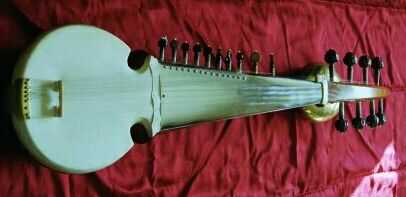
regarding these. In this section, we will simply present the instruments as they are crafted and played
today, without embarking on a lengthy discourse on their history.
Sitar.

The sitar is arguably the most famous of all Indian instruments, its most well known exponent to the
West being Pandit Ravi Shankar. While Western musicians have often employed the sitar as
merely an "effect" in their music, the uninitiated often fail to recognize the incredible depth,
sensitivity and versatility of the instrument.
The structure of the sitar consists of a hollow pumpkin belly covered on the front by a wooden plate.
The neck is carved from the same wood, mostly "toon" wood(Indian mahogany), or Burmese teak.
Stools and bridges are made of deerhorn, frets are made of steel, and tuning pegs are made of wood.
Some players fasten a tomba(wooden resonator) at the top of the neck. The sitar is strung with 1 main melody
strings and a varying number of sympathetic strings. In addition to these are 2 "chikari" strings.
Below these, are the resonating strings, usually 11 in number. The strings are plucked using a "misraf",
a plectrum made of wire which is fastened securely to the fingertip. Melody work is carried out on the,
main melody string, backed by the rhythmic chikari strings, while the underlying strings resonate
with the notes played. Resonating strings are tuned according to the notes used in the raga one intends to play.
The arched frets allow for extreme bending of the melody strings, which is known as "mir" and is
characteristic of the sitar's sound
Surbahar

The surbahar is essentially a bass-sitar. It is tuned in a lower pitch, and uses thicker string gauges. This instrument is mostly used for alap.
Sarod.

The sarod is somewhat less common than the sitar, but shares it's long tradition. It is related to the Afghan “Rabab”
The finest sarods are carved from a single piece of wood, as the sitar, mostly toon or Burmese teak.
The fingerboard is covered by a steel plate, and the belly by a goatskin. The bridges are made of deerhorn.
There are different configurations employed by different players, the number of strings can vary, and
many have a brass resonator fastened at the top of the neck. This sarod has four melody strings,
two chikaris and 19 resonating strings. The strings are plucked by a "jawa", a plectrum made of coconut
shell. The fingerboard is fretless, allowing for long glides, which is characteristic of the sarod.
Mohanveena.

The mohanveena, named after its creator Vishwa Mohan Bhatt, is a modified guitar, adapted to suit
Indian music by reconfiguring the string setup. It has 4 melody strings, 3 chikaris, and 12 resonating
strings. It is crafted in different types of wood, and tuning pegs are made of steel. The instrument is,
in fact, an adaption of an already existent Indian instrument simply called a "guitar", which is basically
the same thing, but without resonating strings. The mohanveena is rested on the lap, and is played like a
steel guitar.Strings are plucked by finger plectrums, and the are stopped by a small steel rod, which
produces a sound that lies somewhere between the sitar and the sarod.
Tabla

Tabla consists of a set of two drums: one treble drum and one bass drum. The treble drum is carved from
wood, and the bass, while sometimes also carved from wood, is more commonly made of metal. On the
drumskins are applied a small patch made of a mixture of iron filings, flour, glue, rice and other
components. These are to improve the pitch. The skins are secured and tuned by a rig of leather straps.
Tanpuri

The tanpuri is a drone instrument which provides the ubiquitous background hum in Indian music, and is
played only in accompaniment to other instruments. It has 4 strings, which are continuously plucked in sequence.